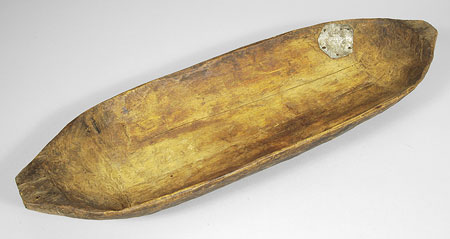Accession Number:
1941.4.65
Country:
Sudan
Region:
[Southern Sudan]
Cultural Group:
Anywaa [Anuak]
Date Made:
By 1941
Materials:
Wood Plant , Tin Metal , Iron Metal
Process:
Carved , Repaired (local) , Perforated , Forged , Hammered , Stamped Embossed Inscribed
Dimensions:
Ht = 115, total L = 780, W = 262; mouth L = 683, W = 250; tin plate L = 72, W = 66, diam hole = 2.5; W handle hole = 7 mm [RTS 3/6/2005].
Weight:
> 1000 g
Other Owners:
Presumably collected by Evans-Pritchard during his period of fieldwork amongst the Anuak between early March and May 1935 [RTS 18/6/2004].
Field Collector:
Edward Evan Evans-Pritchard
PRM Source:
Edward Evan Evans-Pritchard
Acquired:
Found unentered April 1941
Collected Date:
March - May 1935
Description:
Large dish carved from a single block of wood, and consisting of an everted rim that varies from round to flat around its circumference, with walls that flare convexly down and in to a convex base.
It has a lentoid plan view overall, with long sides that taper to either end, at which point the rim widens to create 2 lugs that could be used as handles, one of which has been perforated near its edge.
The interior hollow is oval and has a convex base.
The long side walls are comparatively thin and well carved out, while the vessel has thicker walls at the end, where they no longer follow the outer contour of the vessel closely.
The original colour of the wood appears to be a yellowish brown (Pantone 7509C), but this has darkened in patches across the surface, probably from use.
The vessel is nearly complete, but has a hole in one side wall.
This was repaired locally by using a recycled piece of tin, cut into a rough circle and pierced 6 times around the edge, then placed over the hole and fixed there using narrow iron bars which fitted through the holes and were then bent over at either end to lie against the surface.
Each bar has a square to rectangular section; at present, there are only 5 of the original 6 in place.
The tin has an embossed inscription on its surface; the underside of this is what is visible, so the inscription is in reverse of its normal order.
This reads: 'HIGHLY INFLAMMABLE'.
The wood has developed 3 major cracks along the length of the body.
It has a weight in excess of 1000 grams, and is 115 mm high, with a total length of 780 mm and width of 262 mm, and a mouth that measures 683 by 250 mm across.
The tin mend plate is 72 mm long and 66 mm wide; the holes piercing it have a diameter of 2.5 mm, while the hole through the dish handle is 7 mm in width.
Collected by E.E. Evans-Pritchard during his fieldwork amongst the Anuak, which took place between early March and May 1935 (E.E. Evans-Pritchard, 1940, The Political System of the Anuak of the Anglo-Egyptian Sudan, p. 3).
This type of dish was used for eating meat and fish.
Rachael Sparks 25/9/2005.
Collected by E.E. Evans-Pritchard during his fieldwork amongst the Anuak, which took place between early March and May 1935 (E.E. Evans-Pritchard, 1940, The Political System of the Anuak of the Anglo-Egyptian Sudan, p. 3).
This type of dish was used for eating meat and fish.
Rachael Sparks 25/9/2005.
Primary Documentation:
Accession Book Entry
[p.
576] - E.E.
EVANS-PRITCHAD [sic], Esq., Exeter College, Oxford.
1941.4.65 - ANUAK eating dish for meat & fish, no.
33.
Found unentered in 1941.
Card Catalogue Entry - There is no further information on the catalogue card [RTS 30/1/2004].
Pitt Rivers Museum label - 1941.4.65. ANUAK eating dish for meat or fish. d.d. E. Evans-Pritchard. His number was 33. Found unentered in 1941 [brown luggage label, tied to object; RTS 3/6/2005].
Written on object - Number '92' is written in arabic script on the underside in large, underlined, black painted digits [RTS 3/6/2005].
Card Catalogue Entry - There is no further information on the catalogue card [RTS 30/1/2004].
Pitt Rivers Museum label - 1941.4.65. ANUAK eating dish for meat or fish. d.d. E. Evans-Pritchard. His number was 33. Found unentered in 1941 [brown luggage label, tied to object; RTS 3/6/2005].
Written on object - Number '92' is written in arabic script on the underside in large, underlined, black painted digits [RTS 3/6/2005].






